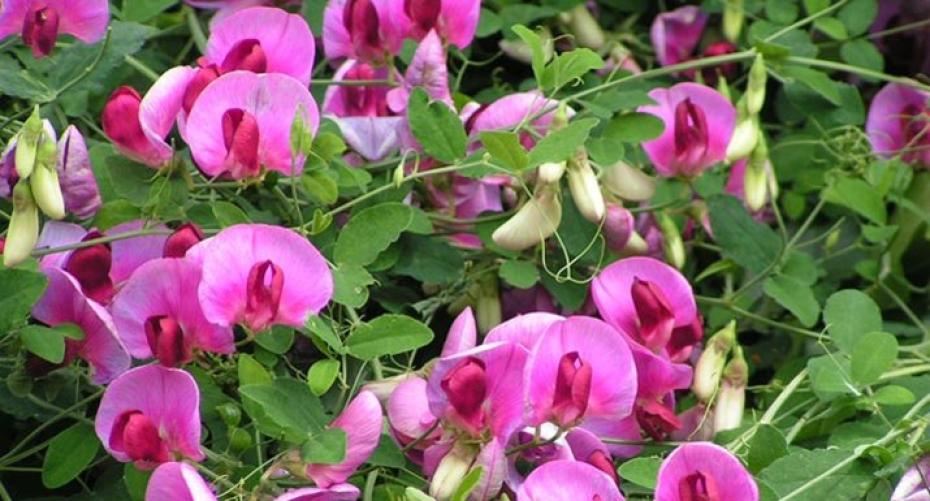Autumn sown seeds give you fresh veg in winter and an earlier spring crop
You can sow some seeds in autumn to crop earlier the following year, therefore prolonging the cropping season. Some need to be kept undercover in a frost-free environment, but some can be sown directly into their cropping positions. As with anything to do with gardening the weather is a major determining factor in the success or failure of the crop, so it may be necessary to cover any crops sown directly outside if there are extreme weather conditions forecast.
Sweet Peas
These can be sown anytime over the winter, from October. Sow a single seed in a Sweet Pea root trainer cell, or, sow 5 around the edge of a 9cm (3.5”) pot. Use a good quality peat-free seed compost and place somewhere cold. Keep just damp, overwatering will result in the seeds rotting over the winter. Once the seedling has produced 3 pairs of leaves, pinch out the top pair. This will encourage the plant to branch out, therefore becoming sturdier and stronger. A weak, leggy plant is more susceptible to disease. Harden off in early spring by putting out during the day, gradually lengthening the time spent outdoors. Plant out in their flowering position from the beginning of May, depending upon where you live. It may be necessary to protect from frost.
Recommended varieties:
Anniversary - cream with a pink picotee edge, strong scent; Beaujolais - dark burgundy, good scent; Cupid Mahogany - dark mahogany purple/red, strong scent, dwarf variety good for hanging baskets and tubs; Cupid Violet - dark violet, strong scent, dwarf variety good for hanging baskets and tubs; Flagship - good blue, strong scent; Gwendoline - white centre going to cerise pink edges, strong scent; Millenium - a good strong red, strong scent; Percy Thrower - lilac/cream, strong scent; Pluto - dark purple, strong scent; White Falls - good scent.
Hardy annuals
Hardy flower annuals can also be sown in early autumn to give an early display of colour; don’t be tempted to try tender annuals or half-hardy annuals as they will not survive the winter. In colder areas of the country you may have to sow them in seed trays in an unheated greenhouse or under a cloche. Don’t sow into too rich soil as this will produce leafy growth instead of flowers.
Recommended varieties:
Ammi majus; Calendula officinalis; Centaurea cyanus (Cornflower) ‘Black Ball’ or ‘Blue Boy’; Cerinthe major purpurascens; Delphiniums; Linum grandiflora (Flax); Nigella damascene (Love-in-a-mist); Scabious.
Spring Cabbage
Sow two seeds (remove the weaker one once they have germinated) in a large module, into a good quality peat-free compost. Place somewhere sheltered, they should be ready to trans-plant outside in about 4 – 6 weeks. Keep just damp, too wet and the seedlings will rot off. Spring cabbages don’t need as much space as summer ones, so plant 15cm (6”) apart and in rows 30cm (12”) apart. You will have to net them, or put a cloche over them, otherwise the pigeons will feast on them. Feed with a high nitrogen fertiliser in spring.
Recommended varieties:
Spring Hero - a good ‘ball’ type, harvest in late spring; Flower of Spring - a tall loose leaved variety, ready to harvest March to May, they can be sown in June and harvested as young leaves in autumn; April; Durham Early.

Onions
Sow the seed directly into the growing site. Thin out as they grow so they are eventually 15 – 20cm (6 - 8”) apart. Onions are widely available as sets, as they are more reliable croppers than sowing seed.
Recommended varieties:
Senshyu Yellow - plant the sets in mid-October, any earlier and they are prone to bolting, harvest in June, about 4 – 6 weeks earlier than spring planted sets; Electric - plant the sets in mid-October, any earlier and they are prone to bolting, harvest in June, about 4 – 6 weeks earlier than spring planted sets; White Lisbon - spring onion; Performer - spring onion.
Garlic
Garlic can be planted in early autumn to harvest in May/June. It needs well drained, neutral soil in full sun. Break up the bulb into individual cloves and plant 3cm (1.5”) deep and 15cm (6”) apart; 30cm (12”) for Elephant Garlic. Apply sulphate of potash in February. Keep well watered in dry periods but stop watering altogether a few weeks before it is due to be harvested. Harvest when the foliage has gone yellow and started to fold over.
Recommended varieties: Bella Italiano; Early Purple Wight; Provence Wight; Tuscany; Elephant Garlic.
Salad leaves
These can be grown on a warm sunny windowsill all through winter. Some varieties can be sown outside in late summer/early autumn and harvested as baby leaves.
Recommended varieties: Spinach ‘Perpetual’; Pak Choi; Corn Salad (Lamb’s lettuce); Winter lettuce ‘Arctic King’.
Radish and turnips can also be sown in late summer/early autumn to harvest later in autumn. ‘Aquadulce Longpod’ is a good broad bean to plant in autumn giving a crop 4 – 6 weeks earlier than a spring sowing.

Strawberries
These are planted from October to April and should crop from May to October provided the varieties are chosen to crop over a long season. Plant them 40 – 45cm (16 – 18”) apart in their cropping site, either outside or in a cold greenhouse. Put a mulch down to keep moisture and warmth in the soil, also to deter slugs. A well-drained, moisture retentive soil is preferable as too wet soil will rot the plants.
Recommended varieties: Anablanca crops early May to June; Elvira crops June to July; Flamenco crops July to October; Florence crops late summer; Mara des Bois crops May to September and tastes like wild strawberries.


